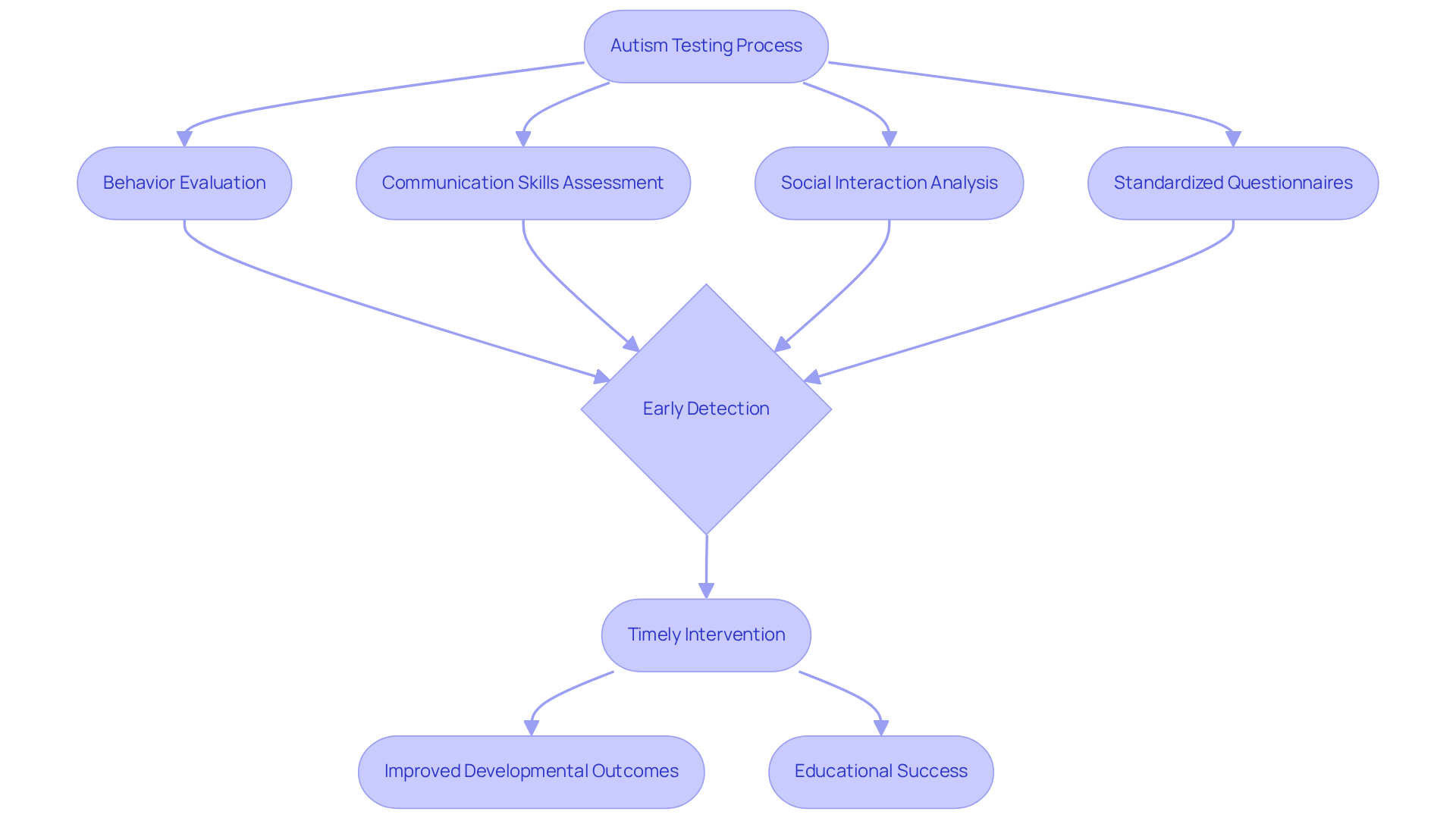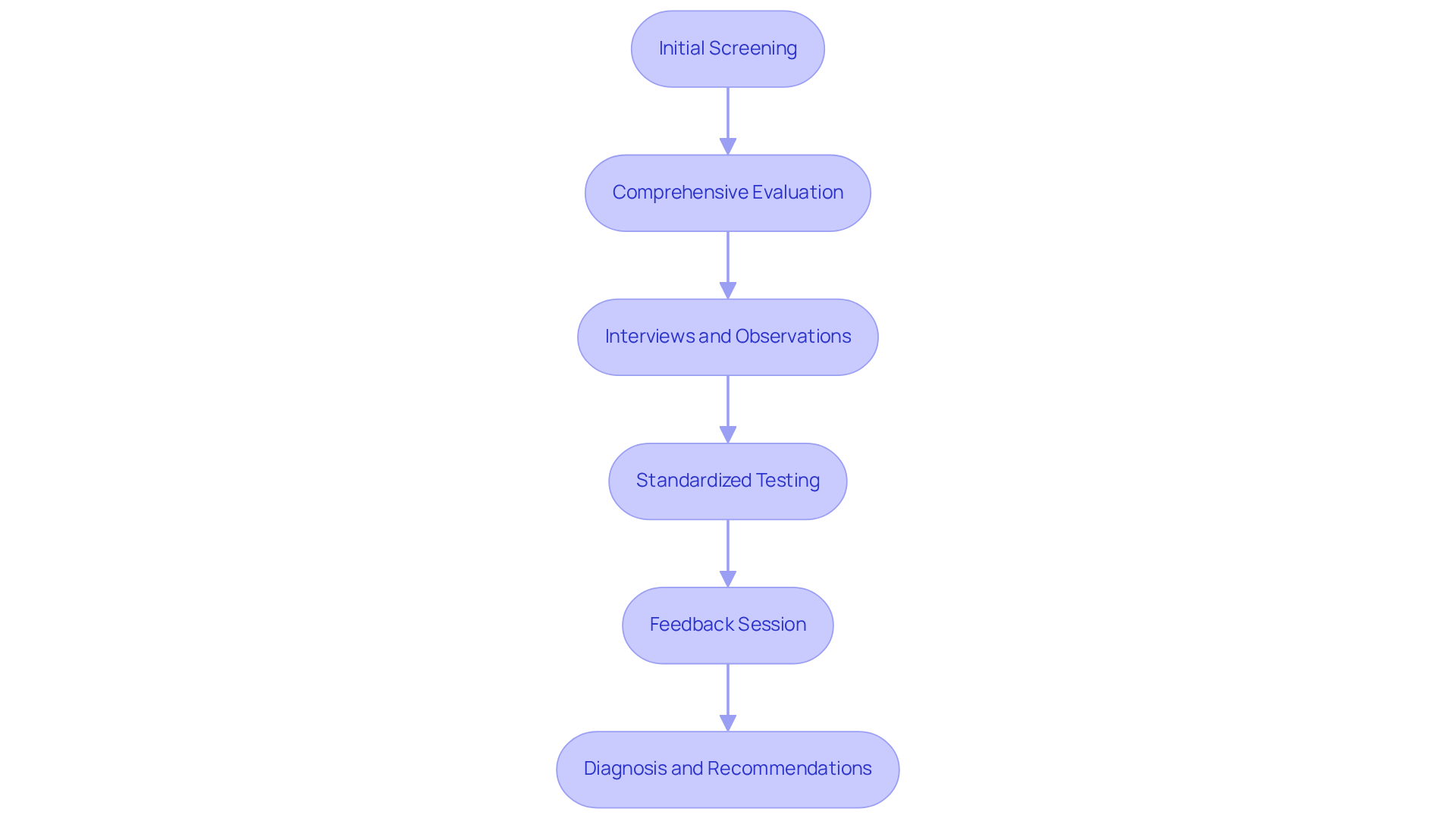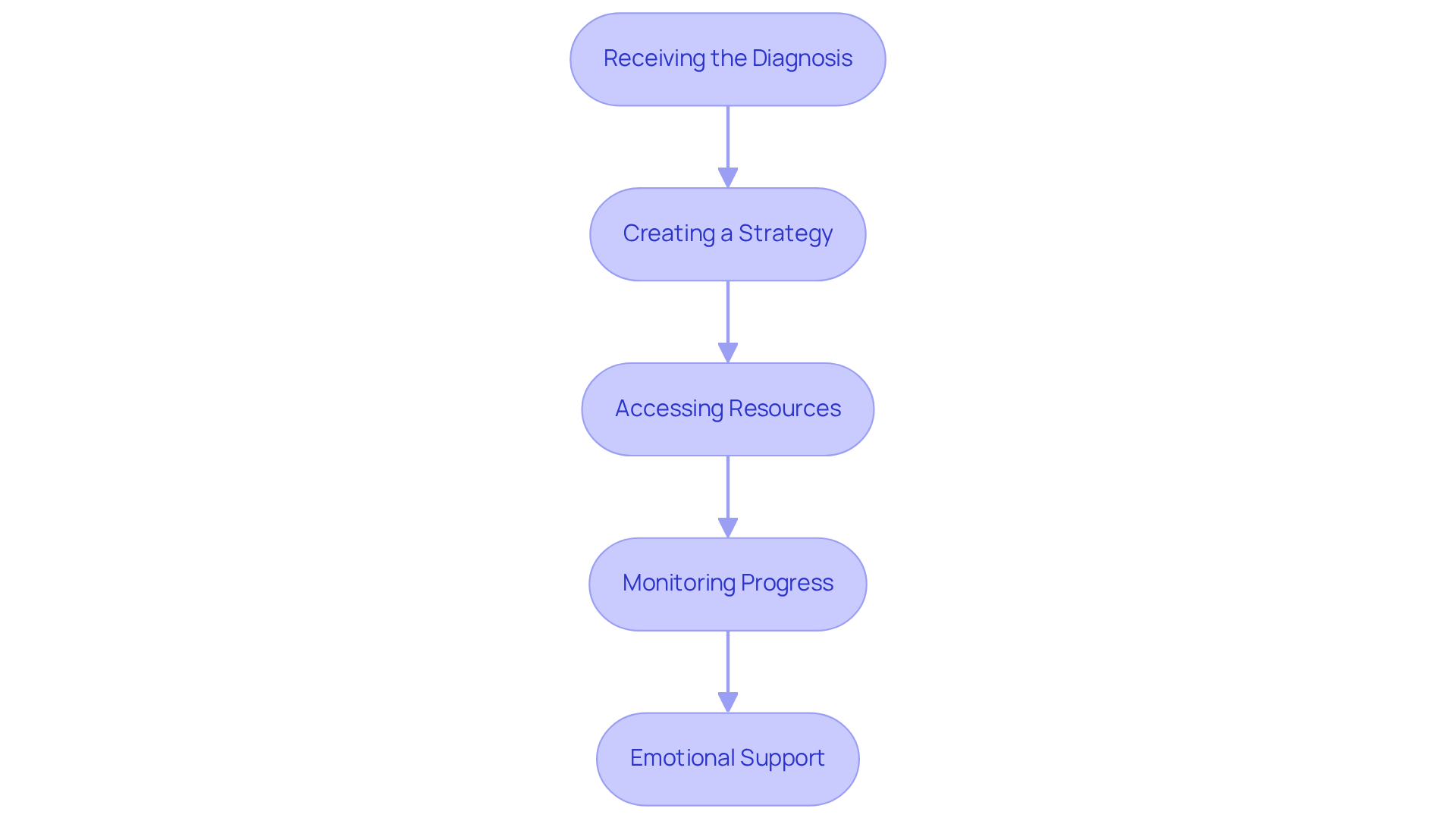Overview
Navigating the autism testing process can be a daunting journey for parents, but understanding its essential steps can make all the difference. Early detection and intervention for Autism Spectrum Disorder (ASD) are crucial, as timely evaluations can significantly improve your child's developmental outcomes. This structured testing process typically begins with:
- Initial screenings
- Comprehensive evaluations
- Tailored support recommendations
As you embark on this path, remember that you are not alone. Many parents have faced similar challenges, and sharing these experiences can foster a sense of community and support. Empowering yourself with knowledge about the testing process allows you to advocate effectively for your child's needs.
Take the time to learn about the resources available to you. By seeking timely evaluations and understanding the structured approach to testing, you can ensure that your child receives the support they deserve. Together, we can navigate this journey with compassion and hope.
Introduction
Navigating the complexities of autism testing can feel overwhelming for parents. This journey is not just about assessments; it’s about the critical role that early detection plays in a child's development. With 1 in 31 youths in the U.S. diagnosed with a developmental disorder, understanding the autism test process becomes essential. Timely interventions can significantly enhance social and communication skills, which is a hope every parent shares. Yet, amidst the sea of information and emotional challenges, many caregivers find themselves asking:
- What are the key steps in this evaluation process?
- How can they effectively support their child post-diagnosis?
These questions are valid and deserve thoughtful answers as we embark on this journey together.
Clarify Autism Testing Concepts and Importance
The aurism test encompasses a comprehensive evaluation process that focuses on understanding a young person's behavior, communication skills, and social interactions. This testing, specifically the aurism test, is crucial; early detection of Autism Spectrum Disorder (ASD) allows for timely intervention, which can lead to significant improvements in developmental outcomes. Research indicates that individuals identified with developmental disorders by age 2 can benefit immensely from programs designed to enhance their social and communication abilities, ultimately fostering better long-term results. Alarmingly, 1 in 31 youths in the U.S. is diagnosed with a developmental disorder, underscoring the urgent need for effective assessment and early support.
Typically, autism evaluations utilize the aurism test along with standardized questionnaires, caregiver interviews, and direct observations of the individual. Together, these components provide experts with a comprehensive understanding of the individual's strengths and challenges, guiding the creation of personalized support strategies. For example, studies have shown that early intervention can significantly alleviate the severity of symptoms and improve educational outcomes. Notably, 74% of autistic students graduate with a diploma, compared to 86% of all students, highlighting the vital role of early diagnosis in enhancing educational success.
Furthermore, disparities in the age of diagnosis reveal that children from lower-income households are diagnosed at an average age of 4.7 years, while those from higher-income households are diagnosed at 5.2 years. This disparity emphasizes the necessity for equitable access to early diagnosis and intervention services. Experts stress the importance of early detection, as it not only aids in securing appropriate resources but also empowers families to navigate the challenges of support more effectively. Additionally, it is crucial to acknowledge that 38% of individuals with ASD also experience seizures, illustrating the complexity of the condition and the need for thorough evaluations. By grasping these concepts, caregivers can approach the testing process with confidence, recognizing it as an essential step in unlocking their child's potential.

Outline the Autism Testing Process Step-by-Step
- Initial Screening: The journey of evaluating developmental disorders often begins with a screening questionnaire filled out by parents or caregivers. This vital tool serves to identify potential developmental concerns, paving the way for early intervention when needed. It's reassuring to know that specialists can reliably diagnose this condition by age 2, underscoring the significance of timely screening.
- Comprehensive Evaluation: If the screening raises concerns about autism, a comprehensive evaluation will be arranged. This process typically involves a multidisciplinary team, including psychologists, speech therapists, and pediatricians, who collaborate to thoroughly assess the young person's needs. Parents should be prepared for a wait time that can vary from several weeks to several months for this comprehensive evaluation.
- Interviews and Observations: During the assessment, professionals will conduct interviews with parents to gather detailed insights into the individual's behavior and developmental history. They will also observe the child in various settings to evaluate social interactions and communication skills effectively. Parents are encouraged to document their concerns about their child's development, as this information can greatly enrich discussions during this phase.
- Standardized Testing: A variety of standardized tests may be administered to assess cognitive abilities, language skills, and adaptive behaviors. These objective measures are crucial for providing a comprehensive understanding of the child's strengths and challenges, significantly contributing to the diagnosis.
- Feedback Session: After the assessment, a feedback session is held where professionals share their findings with the guardians. This session is an invaluable opportunity for parents to ask questions and clarify any uncertainties regarding the evaluation results and their implications.
- Diagnosis and Recommendations: If a developmental disorder is diagnosed, professionals will offer tailored suggestions for interventions and support services. These may encompass various therapy options, educational resources, and community support systems designed to meet the individual’s unique needs. It's important to note that the average age of diagnosis for this condition in the U.S. is 5 years, highlighting the necessity for timely evaluations and interventions.
By following this organized procedure, caregivers can navigate the evaluation journey with greater clarity and confidence, ensuring they are well-prepared for the next steps in supporting their child's growth.

Discuss Outcomes and Next Steps After Testing
Receiving a diagnosis of a developmental disorder can evoke a whirlwind of emotions for caregivers, often blending relief with concern for the future. Understanding the next steps is essential for effective advocacy and support, paving the way for a brighter path ahead:
- Receiving the Diagnosis: When a diagnosis related to neurodevelopmental disorders is confirmed, it becomes vital for guardians to immerse themselves in learning about the condition. This understanding empowers parents to advocate effectively for their children, ensuring they grasp the spectrum of developmental disorders and their implications. With autism affecting 1 in 36 children in the US, according to the CDC, prompt action following diagnosis is crucial.
- Creating a Strategy: Professionals will recommend tailored interventions and support services based on assessment results. Collaborating with therapists and educators to devise a personalized action plan is key, as it addresses the unique needs of the child while establishing clear developmental goals. The collaborative nature of ASD diagnosis highlights the importance of caregiver insights alongside professional evaluations in this journey.
- Accessing Resources: Many organizations and support groups offer invaluable resources for families navigating autism. Parents are encouraged to seek out local and online communities where they can connect with others who share similar experiences, fostering a sense of belonging and support. ASD Media provides a wealth of resources and assistance systems that can greatly benefit parents.
- Monitoring Progress: Regular check-ins with healthcare providers and therapists are vital for tracking the individual’s progress. This ongoing evaluation allows for timely adjustments to interventions, ensuring that the young person receives the best support tailored to their evolving needs.
- Emotional Support: It’s equally important for parents to prioritize their emotional well-being. Research shows that around 50% of mothers of autistic children experience symptoms of depression. Joining support groups or seeking counseling can offer a safe space to share feelings and experiences, helping caregivers navigate the challenges they may face.
By understanding the outcomes of the autism test and taking proactive steps, parents can significantly enhance their child's development and overall well-being.

Conclusion
Navigating the autism testing process is a vital journey for parents eager to understand and support their child's developmental needs. This comprehensive evaluation not only aids in the early detection of Autism Spectrum Disorder (ASD) but also opens the door to timely interventions that can significantly enhance a child's communication skills and social interactions. By recognizing the importance of this process, caregivers can take proactive steps to secure the necessary resources and support for their children.
Throughout this article, we have outlined key steps in the autism testing process:
- Initial screenings
- Comprehensive evaluations
- Feedback sessions
Each phase plays a critical role in shaping our understanding of a child's unique strengths and challenges. Moreover, we have emphasized the importance of equitable access to diagnosis and intervention services, shedding light on the disparities faced by families from different socioeconomic backgrounds. With 1 in 31 youths diagnosed with a developmental disorder, the urgency for effective assessments is undeniable.
Ultimately, the journey does not conclude with a diagnosis. Parents are encouraged to actively engage in their child's development by creating personalized strategies, accessing community resources, and prioritizing their emotional well-being. By taking these steps, families can foster an environment that nurtures growth and development, ensuring that every child has the opportunity to thrive. Embracing the autism testing process as a vital milestone can pave the way for a brighter future for both children and their families.
Frequently Asked Questions
What is the aurism test?
The aurism test is a comprehensive evaluation process that focuses on understanding a young person's behavior, communication skills, and social interactions, specifically for identifying Autism Spectrum Disorder (ASD).
Why is early detection of Autism Spectrum Disorder important?
Early detection of ASD allows for timely intervention, which can lead to significant improvements in developmental outcomes. Research shows that individuals identified with developmental disorders by age 2 can greatly benefit from programs designed to enhance their social and communication abilities.
What are the components of an autism evaluation?
Autism evaluations typically use the aurism test along with standardized questionnaires, caregiver interviews, and direct observations of the individual to provide a comprehensive understanding of their strengths and challenges.
How does early intervention impact individuals with autism?
Early intervention can significantly alleviate the severity of symptoms and improve educational outcomes. Studies indicate that 74% of autistic students graduate with a diploma, highlighting the importance of early diagnosis for educational success.
Are there disparities in the age of autism diagnosis based on socioeconomic status?
Yes, children from lower-income households are diagnosed with autism at an average age of 4.7 years, while those from higher-income households are diagnosed at 5.2 years. This disparity emphasizes the need for equitable access to early diagnosis and intervention services.
What additional health concerns are associated with Autism Spectrum Disorder?
It is noted that 38% of individuals with ASD also experience seizures, indicating the complexity of the condition and the necessity for thorough evaluations.
How can caregivers approach the testing process for autism?
Caregivers can approach the testing process with confidence by understanding it as an essential step in unlocking their child's potential and recognizing the importance of early detection in securing appropriate resources.




